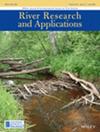Habitat persistency analysis with HEM‐PEAK: A novel approach for the assessment of hydropeaking impacts and mitigation measure design
IF 1.9
4区 环境科学与生态学
Q4 ENVIRONMENTAL SCIENCES
引用次数: 0
Abstract
Hydropeaking is one of the most severe pressures of hydropower on aquatic ecosystems. The discharge fluctuations due to turbine operations cause frequent shifts in hydraulic habitat characteristics such as flow velocity and water depth. Those rapid changes on a daily or sub daily basis, however, are beyond the possibilities of evolutionary adaptations of aquatic organisms, especially for fish in their sensitive early life stages. Thus, one central aim in terms of the evaluation of hydropeaking impacts or the design of mitigation measures is the analysis or establishment of hydraulically stable habitat conditions. This study presents a novel habitat assessment tool to quantify hydraulically stable habitat conditions in the form of a persistency of suitable habitats in hydropeaking reaches. The HEM‐PEAK tool determines areas that contain equal ranges of depth‐averaged flow velocity and water depth for both base flow and peak flow in three categories. Those areas also exclude dewatering sites, which have to be seen as ‘residual risk for stranding’. In the present study, the model was used to evaluate the YOY habitats of brown trout and grayling. The model was tested for 14 hydropeaking reaches to evaluate the quantity of habitat persistency for different morphological characteristics, such as straight, winding, alternating gravel bars and bifurcation reaches. The findings reveal that there is no relationship between hydraulically stable habitat conditions with reach scale bed slope or the magnitude of dewatering areas. However, the changes in specific discharge in relation to bankfull width could be negatively related to the magnitude of hydraulically stable habitat conditions independent of the morphological type. This relationship is minor for summer scenarios compared to spring, as the initial habitat quality during the increased base flow conditions is already limiting the availability of suitable habitats which might have persistency during peak flow. In detail, several self‐forming bars like point bars and artificial structures like groins and coarse rip‐rap could be determined, which could be explicitly addressed in terms of mitigation measure design based on the application of the HEM‐PEAK tool.利用 HEM-PEAK 进行栖息地持续性分析:评估水文影响和设计缓解措施的新方法
水力发电对水生生态系统造成的压力最为严重。水轮机运行造成的排水量波动会频繁改变水流生境特征,如流速和水深。然而,这种每日或次每日的快速变化超出了水生生物进化适应的可能性,尤其是对处于敏感的早期生命阶段的鱼类而言。因此,评估水文影响或设计缓解措施的一个核心目标就是分析或建立水文稳定的生境条件。本研究提出了一种新颖的栖息地评估工具,用于量化水力稳定的栖息地条件,即水力平缓河段适宜栖息地的持久性。HEM-PEAK 工具可确定三个类别中包含基流和峰值流的深度平均流速和水深范围相等的区域。这些区域还不包括脱水地点,因为脱水地点必须被视为 "搁浅的剩余风险"。在本研究中,该模型用于评估褐鳟和灰鳟的幼鱼栖息地。该模型对 14 个水文河段进行了测试,以评估不同形态特征(如直线河段、曲折河段、砾石交替河段和分叉河段)的栖息地持续数量。研究结果表明,水力稳定的生境条件与河段尺度的河床坡度或脱水面积的大小没有关系。然而,与河岸全宽有关的比排水量变化可能与水力稳定生境条件的大小呈负相关,而与形态类型无关。与春季相比,夏季的这种关系较小,因为在基流增加的条件下,最初的生境质量已经限制了适合生境的可用性,而这些生境在峰值流量期间可能具有持续性。具体而言,可以确定几种自形成的栅栏(如点状栅栏)以及人工结构(如沟槽和粗护坡),这些都可以根据 HEM-PEAK 工具的应用,在设计缓解措施时明确解决。
本文章由计算机程序翻译,如有差异,请以英文原文为准。
求助全文
约1分钟内获得全文
求助全文
来源期刊

River Research and Applications
环境科学-环境科学
CiteScore
4.60
自引率
9.10%
发文量
158
审稿时长
6 months
期刊介绍:
River Research and Applications , previously published as Regulated Rivers: Research and Management (1987-2001), is an international journal dedicated to the promotion of basic and applied scientific research on rivers. The journal publishes original scientific and technical papers on biological, ecological, geomorphological, hydrological, engineering and geographical aspects related to rivers in both the developed and developing world. Papers showing how basic studies and new science can be of use in applied problems associated with river management, regulation and restoration are encouraged as is interdisciplinary research concerned directly or indirectly with river management problems.
 求助内容:
求助内容: 应助结果提醒方式:
应助结果提醒方式:


